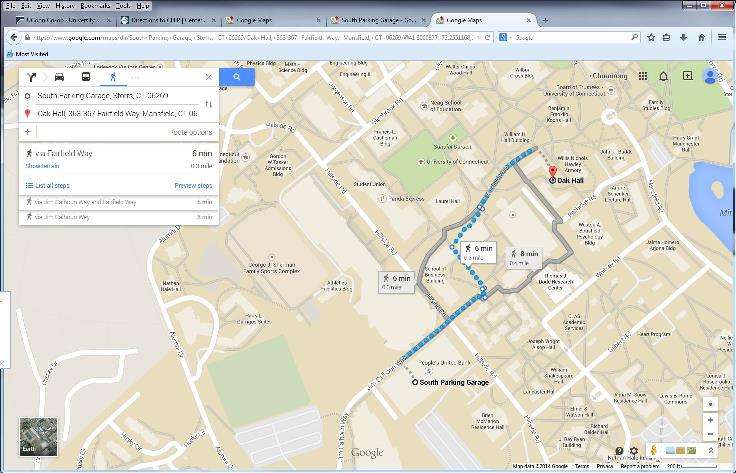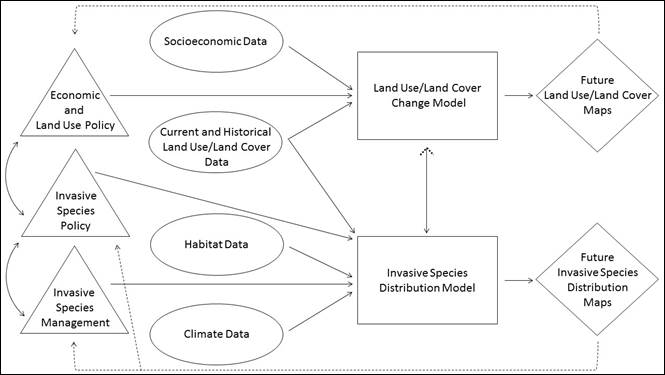Working Group Meeting for the NSF-CNH-Ex project
Date and Time
11:00 am - 4:15 pm, Thursday, Dec, 18th, 2014
Location
Oak Hall, Room 408, on the University of Connecticut Storrs campus
Note:
Please contact Jenica Allen at (434) 825-9107 with questions or concerns on the day of the meeting.
Directions
Driving to South Garage of UConn
Take
I-84 East to Exit 68 in Tolland. At the end of the
exit ramp, turn right and follow 195 South for about 7 miles to UConn. (You
will see the intersection of Routes 195 and 32 after approximately 4 miles, the
intersection of Routes 195 and 44 after another 2 miles, and then campus after
another 1 mile.)
Turn
right onto North Eagleville Road, and follow it until you get to the
intersection with Hillside Road (there is a light at this intersection). Turn
left onto Hillside Road, and follow it until you get to Gampel
Pavilion on the right. Turn right after Gampel
Pavilion to go to the South Parking Garage. Park in the garage. There are also road signs to guide you to the
South Garage.
Walking directions from the South Parking Garage to Oak Hall
1. Exit the garage and head northeast on Jim Calhoun Way toward Hillside Rd (0.1 mi)
2. Turn left on Hillside Rd toward Fairfield Way (56 ft)
3. Turn right toward Fairfield Way (13 ft)
4. Turn left toward Fairfield Way (305 ft)
5. Turn right toward Fairfield Way (292 ft)
6. Turn left toward Fairfield Way (20 ft)
7. Turn right onto Fairfield Way (486 ft)
8. Oak Hall, 362 Fairfield Way

Brief Introduction
The Long Island Sound Watersheds (LISW) landscape has gone through dramatic changes over the past two centuries. For example, up to 90% forests were cleared for farming by the mid-1800s. As farms were abandoned, much of the land has reverted back to mixed hardwood forest. Over the past fifty years, the region has undergone significant land use changes as housing and industrial development has encroached upon formerly rural and forested lands. Invasive alien species present challenging economic and ecological conflicts in the context of land use change: many were introduced via the horticultural trade and some remain economically important to the green industry, yet they are ecologically problematic and are promoted by some types of land use change.
Interactions among human activities, invasive plants, and the future land use changes, as well as the impact of various local, state, or regional policy choices, have not yet been quantified. The many factors that influence the interactions between people, policy, and invasions do not act independently, but form a web of interactions and feedbacks that act on multiple temporal and spatial scales. An approach that is able to incorporate such complexity using multidisciplinary knowledge and skills is needed to address these issues. We have developed a framework (Figure 1) that will rely on economic, policy, landscape, and biological data in addition to expert knowledge. Comparative analyses of land use policy across jurisdictions, coupled with quantitative simulation of multiple management scenarios, should provide novel insight into how land use and invasive plant policies interact.

Figure 1: Modeling overview. Ovals are existing data, rectangles are quantitative models, diamonds are resulting products, and triangles are scenarios based on data and expert input. Arrows indicate flow of information, with dashed lines representing interactions not explicitly included in our current modeling.
The overall objective of this research is to investigate interactions among public and economic policy, land use changes, and invasive plant distributions in Long Island Sound Watersheds (LISW). Our focal study species represent different growth forms and stages of invasion in LISW (Table 1).We expect this research will provide a common tool to forecast land use change and invasive species spread using a scenario approach and quantify spatiotemporal uncertainty of future interactions among human activities, policy choices, land use changes, and species invasion processes at multiple spatial scales. The study will be geographically tiered, with some broad comprehensive analyses carried out for the region as a whole and other more focused analyses conducted for towns that span the policy and invasion spectrum.
Table 1: Study species and basic characteristics
|
Scientific Name |
Common Name |
Invasive Listing |
Growth Form |
|
Alliaria petiolata |
Garlic mustard |
CT, NH, MA, VT |
Herbaceous |
|
Berberis thunbergii |
Japanese barberry |
NH, MA, VT |
Shrub |
|
Celastrus orbiculatus |
Oriental bittersweet |
CT, NH, MA, VT |
Woody vine |
|
Euonymus alatus |
Burning bush |
NH, MA, VT |
Shrub |
|
Phyllostachys aureosulcata |
Yellow-groove bamboo |
None |
Shrub-like grass |
To achieve these goals, we will develop a set of possible economic and policy scenarios driving land use change and invasive species management, develop a new land use change model, improve methodology for modeling invasive species distributions, and complete multi-jurisdiction policy comparisons on projected invasive species abundances.
Updates and more information can be found on the project website: http://gis.geog.uconn.edu/NSFCNHproject/index.html
Goal
The overall goal of this working group meeting of stakeholders is to identify public, economic, and invasive species policies that help to shape land use changes and distributions of invasive species.
Specifically, we hope to:
1. include additional expertise and points of view on land use policy, invasive plant policy, and invasive plant management for guiding development of the proposed land use change model and invasive species distribution models.
2. expand our understanding and inventory of land use and invasive species policies across levels of government (Table 2--viewable here).
3. gain perspective on the economic drivers and trade-offs that relate to invasive species introduction, spread, management, and associated costs.
4. identify key drivers of land use change for developing future scenarios in the region.
5. collect information and data to help create the set of policy scenarios that drive the land use change and invasive species management analysis.
6. explore other potentially important drivers such as population density, housing density, income, road density, and elevation that have helped us to explain patterns of contemporary land use and forest fragmentation at intermediate spatial resolution.
Agenda
11:00am - 11:30am Participant Arrival
11:30am - 12:00pm Introduction & Welcome (Facilitator: Professor Mark Boyer)
12:00pm - 01:00pm Lunch
01:00pm - 04:00pm Group Discussion
04:00pm - 04:15pm Summary & Conclusion
Themes
What are the drivers of land use change and plant invasions?
- 1. What are the main drivers of land use change and how might those drivers change in the future?
- 2. What are economic, social, and other factors affecting new introductions of our targeted species, including information about the demand for and marketing of these species?
What are the trade-offs with invasive (or potentially invasive) species?
- 1. What is the demand for and marketing of our targeted study species?
- 2. What are the costs of removing invasive or potentially invasive plants from the marketplace?
What can we do about invasive species?
- 1. What are the major public, economic, and management policies that are effective at influencing land use change and controlling invasive plants?
- 2. At what level of government should these policies be implemented?
- 3. How should different levels of policy be changed to lead to the sustainable development in this region?
- 4. What are the potential tradeoffs in setting policies at the local vs. state, regional, or federal levels for effective management of land use and invasive plants?
Meeting Memo
NSF-CNH-Ex Working Group Meeting Notes
Photo Gallery
List of Participants
|
Name |
Affiliation |
Sector/Expertise |
|
Matt Aiello-Lammens |
UConn, Postdoctoral Researcher |
Ecologist, invasion biology |
|
Jenica Allen |
UMass Amherst, Postdoctoral Researcher and UConn, Assistant Research Scientist |
Ecologist, conservation and invasion biology |
|
Chet Arnold |
CLEAR, Co-Director |
State land use regulations and land demand |
|
Nancy Balcom |
Connecticut SeaGrant, Associate Director |
State and local environmental policy and management |
|
Juliana Barrett |
Connecticut SeaGrant, Associate Extension Educator |
State and local ecological impacts of land use |
|
Amanda Bertino |
UMass Amherst, Undergraduate research assistant |
Environmental conservation, invasives management |
|
Cynthia Boettner |
Silvio O. Conte National Fish & Wildlife Refuge, Invasive Plant Control Coordinator |
Regional invasives policy and management |
|
Mark Boyer |
UConn, Professor |
Political Science, environmental policy |
|
Tianjie Chen |
UConn, Graduate research assistant |
Economics |
|
Mike Dietz |
CT NEMO, Director |
State land use regulations and land demand |
|
Donna Ellis |
State Extension Educator, CIPWG Co-chair |
State invasives policy and management |
|
Nichole Gableman |
Connecticut Invasive Plant Council, Coordinator |
State and local invasives management and policy |
|
Shougeng Hu |
UConn, Visiting Professor |
Land Use change and evaluation |
|
Qinglin Hu |
UConn, Graduate research assistant |
Geography, land use change |
|
Bill Hyatt |
CT DEEP, Natural Resources Bureau Chief |
State environmental policy and management |
|
Bruce Hyde |
CLEAR, Land Use Educator (& former municipal planner) |
State and local land use regulations |
|
Paul Larson |
Sprucedale Gardens, Owner |
State horticultural industry |
|
Weidong Li |
UConn, Research Professor |
Geography, land use change |
|
Christopher Martin |
CT DEEP, State Forester |
State forest management and planning |
|
Chris Polatin |
Polatin Ecological Services, Inc., Habitat Restoration Specialist |
Regional invasives management contractor |
|
Charlotte Pyle |
USDA-NRCS, Landscape Ecologist |
Regional invasives policy and management |
|
Gina Ramos |
BLM, Invasive Species Coordinator |
National and regional (western) invasive plant policy |
|
Kathy Segerson |
UConn, Professor |
Economics, natural resource economics |
|
John Silander |
UConn, Research Professor |
Ecology, conservation and invasion biology |
|
David Sutherland |
Nature Conservancy, CT Chapter, Director of Government Relations |
State environmental policy |
|
Natalie Vieira |
UConn, Undergraduate research assistant |
Political Science |
|
Weixing Zhang |
UConn, Graduate research assistant |
Geography, land use change |
|
Chuanrong Zhang |
UConn, Associate Professor |
Geography, land use change |
|
Haitao Zhang |
UConn, Visiting Associate Professor |
Land use change and evaluation |
Connect With Us